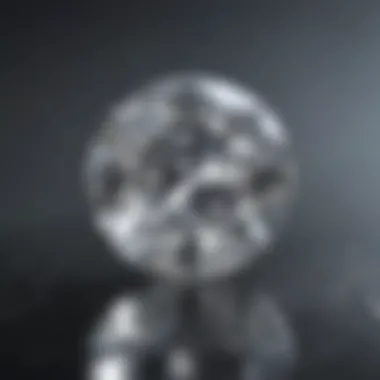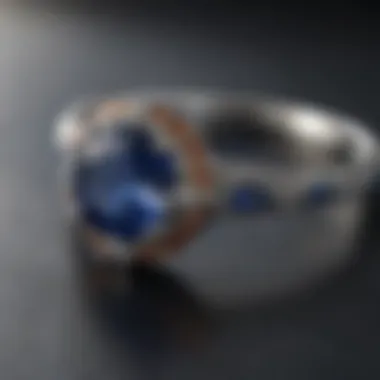The Multifaceted Value of White Sapphires Explained


Intro
White sapphires present a unique option for those seeking beauty and value in gemstones. Like many other precious stones, they can be analyzed from multiple perspectives, including their aesthetic appeal and economic worth. However, white sapphires hold specific characteristics that set them apart, especially when compared to diamonds. Understanding these aspects is crucial for gemstone enthusiasts, collectors, and jewelry designers, as it elevates appreciation for this remarkable stone.
Gemstone Overview
Definition of Gemstones
Gemstones are naturally occurring minerals or organic materials that have been cut and polished for use in jewelry and decorative items. They are celebrated not only for their beauty but also for their rarity and durability.
Classification of Gemstones
Gemstones can typically be classified into two categories: precious and semi-precious. While diamonds, rubies, sapphires, and emeralds fall under precious stones, others like amethyst and garnet are categorized as semi-precious. White sapphires are specifically part of the corundum family, which includes all varieties of sapphire, distinguished by their lack of color.
Historical Significance
Origins of Gemstone Use
The use of gemstones dates back thousands of years. Early civilizations utilized them for various purposes, including decoration, currency, and in rituals. White sapphires, though less common than their colored counterparts, have a storied past amongst royal families and nobility.
Cultural Insights: Gemstones in Ancient Civilizations
In many ancient cultures, gemstones were imbued with meanings and powers. White sapphires were sometimes used as a symbol of purity and wisdom. Ancient Greeks believed that these stones could enhance clarity of thought and bring good fortune to the wearer. In Indian culture, they are associated with the planet Venus and said to bring love and harmony. Understanding these connections helps illuminate the ongoing relevance of white sapphires in contemporary jewelry.
White sapphires, often overshadowed by diamonds, possess unique qualities that provide both emotional and financial returns on investment.
Preamble to White Sapphires
White sapphires offer a fascinating alternative to more traditional gemstones, particularly diamonds. Understanding these gemstones is essential for anyone interested in jewelry or gemstone collection. This section will explore how white sapphires stand out, their unique attributes, and their role in the modern gem market.
The allure of white sapphires lies not only in their appearance but also in their versatility and affordability. In jewelry, they can serve many purposes, from elegant rings to simple pendants. These characteristics make white sapphires attractive for both everyday wear and special occasions. The growing trend in custom jewelry highlights the significance of white sapphires as a choice that doesn’t compromise on beauty or quality.
Definition and Characteristics
White sapphires are colorless gemstones belonging to the corundum family. They are formed under high-pressure conditions deep within the Earth's crust. This specific formation process gives them a high durability, making them an excellent option for everyday jewelry. Their hardness ranks a 9 on the Mohs scale, which is just below diamonds, providing excellent resistance to scratches and damage.
Physical characteristics include clarity and brilliance. Unlike diamonds, which can have internal flaws, high-quality white sapphires are generally eye-clean. They exhibit great light refraction, contributing to their sparkle. The gems are often cut in various shapes, similar to diamonds, to enhance their aesthetic appeal.
Comparison with Diamonds
Although white sapphires are often considered a diamond substitute, fundamental differences exist between the two. Firstly, the price point for white sapphires is significantly lower than that of diamonds. This affordability makes them attractive for buyers who desire the appearance of a diamond without the associated cost.
Another key difference lies in clarity. While diamonds may contain inclusions, high-grade white sapphires typically do not. However, diamonds can display more fire, a term used to describe the colorful flashes of light that occur when light passes through them.
In terms of symbolism, diamonds are often associated with luxury and commitment, especially in engagement rings. White sapphires, on the other hand, can convey a more understated elegance. They can symbolize wisdom and peace, appealing to consumers looking for a different type of below-the-radar beauty.
Since both gems have unique qualities, choosing between a white sapphire and a diamond should be based on personal preference and budget considerations.
In summary, while white sapphires and diamonds share some visual similarities, their variances in price, clarity, and symbolism can influence purchasing decisions.
Historical Context
Understanding the historical context of white sapphires adds depth to their appreciation and value. It reveals how these gemstones have been perceived and utilized over time, influencing their demand in both historical and contemporary markets. White sapphires are not just beautiful; they carry with them stories and significances that resonate across different cultures. This section aims to provide insights into their ancient uses and the cultural roles they played, thus enhancing the reader's overall understanding of their multifaceted value.


Ancient Use and Symbolism
White sapphires, like many gemstones, have been revered since ancient times. They were often associated with purity, wisdom, and divine favor. In various ancient civilizations, including Greece and Egypt, white sapphires were used in jewelry worn by royalty or to adorn sacred objects. The Greeks believed that these stones could help guide the soul toward enlightenment. Egyptian pharaohs valued them for their supposed protective qualities, wearing them during burial to ensure safe passage to the afterlife. Their brilliance and clarity made them symbols of wealth and status.
Additionally, many cultures ascribed specific properties to white sapphires. They were thought to enhance spiritual insight and promote mental clarity. This symbolic value has not diminished. In today’s market, they continue to hold significance for those who appreciate not only their beauty but also what they represent on a deeper level.
Cultural Significance Across Civilizations
The cultural impact of white sapphires is evident in various civilizations throughout history. In India, they are treasured in astrology and are believed to hold a significant connection to the planet Venus. This connection fosters the idea that wearing white sapphires can bring stability and love into one’s life. Furthermore, they have significance in Hindu rituals, being used in various ceremonial ornaments.
In medieval Europe, white sapphires were often mistaken for diamonds and were included in royal collections. This association with nobility continued well into the Renaissance period, where they were part of bridal ornaments, signifying purity and fidelity.
Today, references to white sapphires appear in literature and art, showcasing their lasting influence. Their representation in modern jewelry often draws from historical significance, further enriching their narrative.
"White sapphires embody more than just beauty; they are historical treasures carrying legacies of ancient wisdom and cultural depth."
Gemological Properties
Understanding gemological properties is crucial in evaluating the value and appeal of white sapphires. These properties encompass both the physical composition of the gemstone and its optical characteristics. They help define a white sapphire's quality and distinguish it from other gemstones. For jewelry enthusiasts and collectors, comprehending these elements can significantly impact purchasing decisions and future investments.
Physical Properties and Composition
White sapphires are primarily composed of aluminum oxide, which belongs to the corundum family of minerals. Their unique hardness rating of 9 on the Mohs scale makes them an excellent choice for everyday wear. This durability is only surpassed by diamonds, providing resilience against scratches and damage. White sapphires often contain trace elements like iron and titanium, which can influence their clarity and overall appearance.
"The hardness of white sapphires ensures they remain beautiful over time, making them a practical gemstone choice."
When assessing a white sapphire, several factors are critical:
- Color: Although white sapphires are generally colorless, some may have a hint of yellow or gray. Ideally, the purer the white, the more valuable the stone.
- Clarity: Higher clarity stones with fewer inclusions are more sought after.
- Cut: The skill with which a stone is cut influences its brilliance and overall value. Well-cut sapphires will reflect light effectively, enhancing their attractiveness.
Considering these physical properties helps buyers determine the inherent worth of a white sapphire and contributes to informed purchasing choices.
Optical Characteristics
The optical characteristics of white sapphires also play a vital role in their overall value. The primary factor here is brilliance, which is affected by how well light enters and exits the stone. A well-cut white sapphire exhibits a distinctive sparkle, comparable to that of a diamond.
White sapphires have excellent light dispersion. This property allows them to reflect light well, creating flashes of color that can enhance their visual appeal. Another significant characteristic is their transparency. A transparent stone can catch and reflect light in pleasing ways, increasing its desirability in the jewelry market.
Key optical considerations include:
- Refractive Index: White sapphires have a refractive index ranging from 1.76 to 1.77, contributing to their brilliance.
- Pleochroism: Unlike many colored gemstones, white sapphires typically do not show pleochroism. This characteristic can make these stones appear more consistent in color when viewed from different angles.
- Dispersion: The dispersion characteristic contributes to the fire of the stone, which is the colorful flashes seen in well-cut gems.
Overall, understanding these optical properties enhances appreciation for white sapphires and aids buyers in making choices aligned with their aesthetic preferences and investment goals.
Market Demand and Economic Factors
Understanding the market demand and economic factors surrounding white sapphires is essential for both buyers and sellers in the gemstone industry. The popularity of white sapphires has grown in recent years, influenced by a variety of economic conditions, consumer preferences, and cultural trends. By examining these elements, one can gain insights into how these factors affect the price and availability of white sapphires in the marketplace.
Current Trends in White Sapphire Pricing
The pricing of white sapphires reflects not only their aesthetic qualities but also broader market trends. Currently, the demand for white sapphires has been on the rise, particularly among consumers looking for alternatives to traditional diamonds. This shift occurs for several reasons:
- Affordability: With the rising costs of diamonds, many consumers are seeking more cost-effective options. White sapphires provide a similar look at a fraction of the price.
- Sustainability Concerns: Increasing awareness regarding ethical sourcing has made many individuals uneasy about diamond mining. White sapphires are often lab-created or sourced sustainably, appealing to conscientious buyers.
- Fashion Trends: The jewelry industry often sees cycles of popularity with different gemstones. Celebrities and influencers have increasingly showcased white sapphires in their jewelry collections, contributing to a resurgence in demand.


Prices can vary significantly based on clarity, cut, and size. According to market reports, the average cost for high-quality white sapphires can range between $300 to $800 per carat, depending on these factors.
Factors Influencing Value
Several factors can influence the value of white sapphires. Understanding these elements provides insight into what drives pricing in the market:
- Quality of Cut: The craftsmanship involved in cutting a white sapphire can greatly affect its brilliance and overall appeal. Well-cut stones typically command higher prices.
- Clarity Levels: The clarity of a gemstone is crucial. White sapphires, like any other precious stones, are graded based on the presence of inclusions and blemishes. Higher clarity generally means higher value.
- Origin: Where the sapphire is sourced can impact its desirability. Stones from reputable sources might carry a premium due to their perceived quality.
- Market Demand Fluctuations: Economic factors, such as shifts in consumer behavior or global economic conditions, can lead to changes in demand. An increase in interest in ethical and sustainable gems can also influence pricing.
"Anticipating changes in market trends can be essential for both collectors and those looking to purchase white sapphires."
In summary, understanding the market demand and economic factors relating to white sapphires can empower consumers and investors alike. Recognizing trends, pricing structures, and the various elements influencing value allows for more informed decisions when it comes to these increasingly popular gemstones.
Choosing White Sapphires
Selecting a white sapphire is a decision rooted in both aesthetic preference and practical considerations. Understanding what to look for when choosing one can significantly affect the overall satisfaction and value of the stone. Unlike diamonds, which are traditionally viewed as the standard in regard to gemstone quality and beauty, white sapphires offer unique characteristics and benefits that should be considered.
One of the most critical elements in choosing a white sapphire is understanding the quality factors. These include color, clarity, cut, and carat weight. Each factor plays a substantial role in determining the overall value of the gemstone.
Quality Factors to Consider
When evaluating white sapphires, the color should always be a priority. High-quality white sapphires exhibit a pure, crystal-like clarity with no noticeable hue. It's important to inspect the stone under various lighting conditions to appreciate its true color.
Clarity is also essential. The fewer inclusions or blemishes present, the more valuable the sapphire will be. An ideal white sapphire should be eye-clean, meaning that any flaws are not visible to the naked eye. Here are factors to evaluate in clarity:
- Inclusions: Evaluate the presence of internal flaws.
- Blemishes: Look for external imperfections on the surface.
The cut of the white sapphire influences its sparkle and overall appearance. A well-cut sapphire will reflect light beautifully, enhancing its brilliance. Consider the following shapes:
- Oval
- Round
- Cushion
Finally, carat weight is an important aspect. Larger stones tend to be more valuable, but size should not compromise quality. Assessing the balance of these factors is crucial in selecting a white sapphire that meets both aesthetic and financial expectations.
Certification and Authenticity
Certifying the authenticity of a white sapphire is paramount when making a purchase. Gemstones can be misrepresented or misnamed, which can lead to disappointment. Seek certifications from reputable organizations like the Gemological Institute of America (GIA) or the International Gemological Institute (IGI). These institutions provide reports detailing essential characteristics and confirming the authenticity of the gemstone.
Moreover, asking for a gemstone identification report ensures the stone is genuinely a white sapphire and not another less valuable or synthetic stone. Additionally, check if the retailer offers return policies or guarantees if for any reason you are dissatisfied with your purchase.
When navigating the world of white sapphires, being well-informed and cautious can lead to choosing a gem of lasting beauty and value. Trustworthy sellers, proper certification, and knowledge of quality factors will help ensure you make a wise investment in this alluring white gemstone.
Jewelry Applications
Jewelry applications play a pivotal role in understanding the value of white sapphires. Their aesthetic versatility allows them to be used in various jewelry types, from elegant rings to intricate necklaces. Such diversity appeals to a wide audience, making them a favored choice among gem enthusiasts, collectors, and designers. White sapphires have gained popularity not only for their visual attributes but also for their durability, leading to greater market acceptance and demand.
Popular Settings and Designs
When considering white sapphires for jewelry, it is essential to explore popular settings and designs. White sapphires can fit seamlessly in both classic and contemporary styles. Here are some notable settings:
- Solitaire Settings: This classic design features a single white sapphire, emphasizing its brilliance. It works wonderfully for engagement rings, allowing the stone's clarity and sparkle to shine.
- Halo Settings: Surrounded by smaller gemstones, halo settings provide an additional sparkle effect. This style enhances the overall glamour of the white sapphire, making it a stunning centerpiece.
- Three-Stone Rings: The three-stone design symbolizes the past, present, and future. Using white sapphires in this setting can carry great significance, making it meaningful for special occasions like anniversaries.
- Pendant Necklaces: White sapphires can be an attractive choice for pendants. A sleek design can draw attention to the intricacies of the stone, combining elegance and simplicity.
These designs showcase the adaptability of white sapphires in various styles, highlighting their appeal to different audiences.
Custom Jewelry Considerations


Custom jewelry stands out for its personalized touch. When considering white sapphires for custom pieces, several factors come into play:
- Personal Significance: Custom pieces often reflect personal stories. Selecting white sapphires based on meaningful attributes can enhance emotional value.
- Design Preferences: Working with designers allows clients to tailor styles that align with their vision. This process considers not only aesthetics but also the quality and settings of the gemstone.
- Budget Considerations: Establishing a budget is essential. Custom jewelry can range widely in price based on materials, craftsmanship, and the size of the white sapphire.
- Engagement with the Designer: Active communication with the designer helps ensure that the final piece meets expectations. Collaboration yields creations that can be both beautiful and meaningful.
These considerations emphasize the uniqueness of custom jewelry applications involving white sapphires. They facilitate an opportunity for individuals to express themselves through finely crafted pieces.
Care and Maintenance
Caring for white sapphires is essential in preserving their beauty and ensuring their longevity. These gems, like all precious stones, require specific maintenance to avoid damage and maintain their enchanting appearance. Proper care not only enhances their aesthetic appeal but also plays a significant role in their overall value. Let’s explore the cleaning techniques and storage recommendations that are vital for any owner of white sapphires.
Cleaning Techniques
When it comes to cleaning white sapphires, simplicity and caution are key. Here are some effective techniques:
- Mild Soap and Water: The most recommended method is to use a solution made of mild soap and warm water.
Mix a few drops of liquid dish soap in warm water, then soak the gemstone for a few minutes.
After soaking, gently scrub the sapphire with a soft-bristled brush to remove any dust or residues. - Avoid Harsh Chemicals: Always refrain from using harsh chemicals or bleach. These can damage the stone or its setting.
- Ultrasonic Cleaners: If you prefer using ultrasonic cleaners, verify that your white sapphire is intact and not at risk of damage. Some gemstones may become loose in their settings, leading to potential loss.
"Regular cleaning can prevent build-up that dulls the stone, ensuring its clarity and brilliance remain intact."
Storage Recommendations
Proper storage of white sapphires greatly influences their sustenance. Here are some important recommendations:
- Use Soft Pouches or Boxes: Store white sapphires in a soft cloth pouch or a dedicated jewelry box. This prevents scratching against other jewelry pieces.
- Separated Storage: Ideally, it’s best to keep white sapphires separate from other gemstones, especially harder stones like diamonds. This reduces the chance of abrasion or damage.
- Controlled Environment: Ensure the storage area is dry and cool. Excess humidity or heat can lead to unwanted alterations in the stone’s settings or even the gem itself.
By giving attention to cleaning and storage methods, one can enjoy white sapphires for many years while keeping their value intact. Regular care ensures these beautiful gemstones maintain their status, both in jewelry and in the eyes of collectors.
The Role of White Sapphires in Modern Culture
White sapphires hold a unique place in modern culture, especially within the context of jewelry and fashion. The rising popularity of these stones reflects a broader shift toward sustainability and ethical considerations in gemstone selection. As consumers become more aware of the implications of their purchasing decisions, white sapphires stand out as a viable alternative to traditional diamonds.
White Sapphires in Fashion
White sapphires have made substantial impacts on fashionable jewelry designs. Their versatility allows them to be incorporated into various styles, from classic to contemporary. Jewelry designers appreciate their ability to mimic the look of diamonds while often being less expensive and more ethical. This aspect of white sapphires appeals particularly to a younger demographic who are increasingly seeking sustainable options.
Moreover, white sapphires can enhance design aesthetics. They can be used as center stones, accent stones, or in intricate settings. Their clear brilliance and subtle elegance complement numerous materials such as gold, silver, and platinum. This adaptability enables white sapphires to fit seamlessly into both casual and formal attire, making them a favored choice among fashion-forward individuals.
Symbolism in Contemporary Society
In today's society, the symbolism of white sapphires extends beyond mere aesthetics. Often associated with clarity, purity, and wisdom, these gemstones are now considered significant in various social contexts. Many view them as symbols of commitment and love, paralleling the traditional meanings linked to diamonds.
Additionally, white sapphires are sometimes favored for engagement rings due to their unique characteristics and ethical stance. They may represent a thoughtful choice that prioritizes personal values over established norms.
"White sapphires encase the ideals of beauty and integrity in modern society. They serve as an emblem of a mindful lifestyle, resonating with those who seek meaning in their choices."
Culmination
The conclusion of this article on white sapphires is vital, as it synthesizes the key findings and underscores the relevance of this gemstone. Understanding the value of white sapphires involves appreciating their unique aesthetic appeal, historical context, and market dynamics.
Recap of White Sapphire Value
White sapphires are notable for their clarity and colorlessness, making them a popular alternative to diamonds. Their characteristics, such as durability and affordability, make them appealing to a broader audience. These stones are often seen in various types of jewelry, transcending traditional methods of adornment. The historical significance enhances their allure, weaving a captivating narrative of use from ancient times to modern-day fashion. Collectors and enthusiasts often find white sapphires to be not only beautiful but also a worthwhile investment due to their potential in the gem market.
"In understanding gemstones like white sapphires, one realizes that beauty and value often exist in the same sphere."
Future Prospects in the Gem Market
The future of white sapphires in the gem market looks optimistic. As consumer interest shifts toward ethically sourced stones, white sapphires are gaining attention for being a less expensive and equally stunning option compared to traditional diamonds. The ongoing rise in e-commerce and social media marketing adds to their visibility, enabling new buyers to discover these gems. With increasing demand for sustainable jewelry choices, white sapphires may see a significant enhancement in their market position.
The blend of unique beauty, historical richness, and affordability positions white sapphires as a compelling choice for both jewelry designers and consumers. As more individuals recognize their value, the future of white sapphires could lead to a broader acceptance and increased prominence in the gemstone industry.



